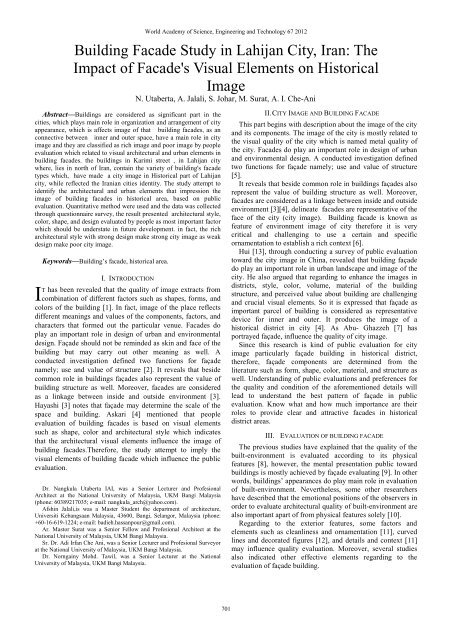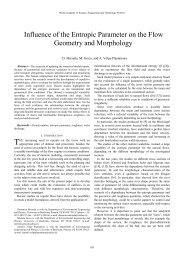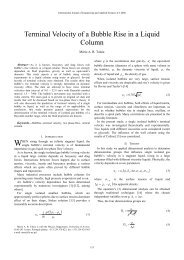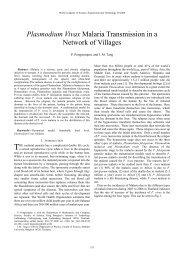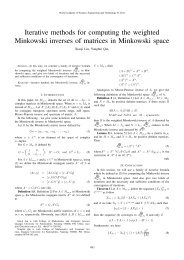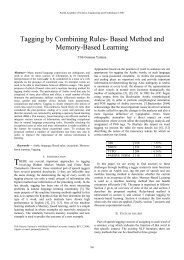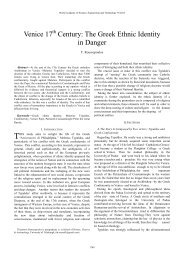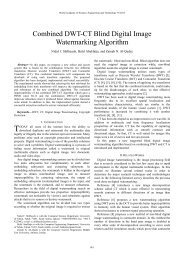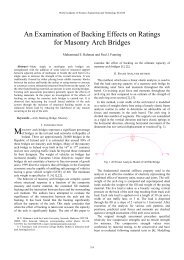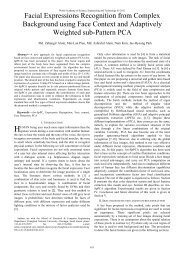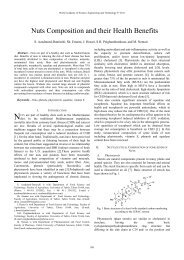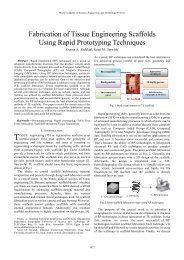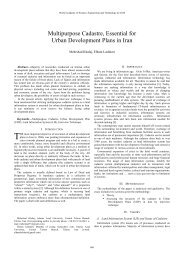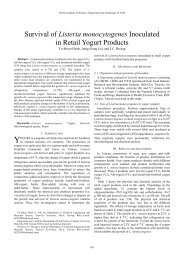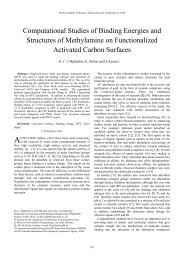Building Facade Study in Lahijan City, Iran - World Academy of ...
Building Facade Study in Lahijan City, Iran - World Academy of ...
Building Facade Study in Lahijan City, Iran - World Academy of ...
Create successful ePaper yourself
Turn your PDF publications into a flip-book with our unique Google optimized e-Paper software.
Abstract—<strong>Build<strong>in</strong>g</strong>s are considered as significant part <strong>in</strong> the<br />
cities, which plays ma<strong>in</strong> role <strong>in</strong> organization and arrangement <strong>of</strong> city<br />
appearance, which is affects image <strong>of</strong> that build<strong>in</strong>g facades, as an<br />
connective between <strong>in</strong>ner and outer space, have a ma<strong>in</strong> role <strong>in</strong> city<br />
image and they are classified as rich image and poor image by people<br />
evaluation which related to visual architectural and urban elements <strong>in</strong><br />
build<strong>in</strong>g facades. the build<strong>in</strong>gs <strong>in</strong> Karimi street , <strong>in</strong> <strong>Lahijan</strong> city<br />
where, lies <strong>in</strong> north <strong>of</strong> <strong>Iran</strong>, conta<strong>in</strong> the variety <strong>of</strong> build<strong>in</strong>g's facade<br />
types which, have made a city image <strong>in</strong> Historical part <strong>of</strong> <strong>Lahijan</strong><br />
city, while reflected the <strong>Iran</strong>ian cities identity. The study attempt to<br />
identify the architectural and urban elements that impression the<br />
image <strong>of</strong> build<strong>in</strong>g facades <strong>in</strong> historical area, based on public<br />
evaluation. Quantitative method were used and the data was collected<br />
through questionnaire survey, the result presented architectural style,<br />
color, shape, and design evaluated by people as most important factor<br />
which should be understate <strong>in</strong> future development. <strong>in</strong> fact, the rich<br />
architectural style with strong design make strong city image as weak<br />
design make poor city image.<br />
I<br />
Keywords—<strong>Build<strong>in</strong>g</strong>’s facade, historical area.<br />
I. INTRODUCTION<br />
T has been revealed that the quality <strong>of</strong> image extracts from<br />
comb<strong>in</strong>ation <strong>of</strong> different factors such as shapes, forms, and<br />
colors <strong>of</strong> the build<strong>in</strong>g [1]. In fact, image <strong>of</strong> the place reflects<br />
different mean<strong>in</strong>gs and values <strong>of</strong> the components, factors, and<br />
characters that formed out the particular venue. <strong>Facade</strong>s do<br />
play an important role <strong>in</strong> design <strong>of</strong> urban and environmental<br />
design. Façade should not be rem<strong>in</strong>ded as sk<strong>in</strong> and face <strong>of</strong> the<br />
build<strong>in</strong>g but may carry out other mean<strong>in</strong>g as well. A<br />
conducted <strong>in</strong>vestigation def<strong>in</strong>ed two functions for façade<br />
namely; use and value <strong>of</strong> structure [2]. It reveals that beside<br />
common role <strong>in</strong> build<strong>in</strong>gs façades also represent the value <strong>of</strong><br />
build<strong>in</strong>g structure as well. Moreover, facades are considered<br />
as a l<strong>in</strong>kage between <strong>in</strong>side and outside environment [3].<br />
Hayashi [3] notes that façade may determ<strong>in</strong>e the scale <strong>of</strong> the<br />
space and build<strong>in</strong>g. Askari [4] mentioned that people<br />
evaluation <strong>of</strong> build<strong>in</strong>g facades is based on visual elements<br />
such as shape, color and architectural style which <strong>in</strong>dicates<br />
that the architectural visual elements <strong>in</strong>fluence the image <strong>of</strong><br />
build<strong>in</strong>g facades.Therefore, the study attempt to imply the<br />
visual elements <strong>of</strong> build<strong>in</strong>g facade which <strong>in</strong>fluence the public<br />
evaluation.<br />
Dr. Nangkula Utaberta IAI, was a Senior Lecturer and Pr<strong>of</strong>esional<br />
Architect at the National University <strong>of</strong> Malaysia, UKM Bangi Malaysia<br />
(phone: 60389217035; e-mail: nangkula_arch@yahoo.com).<br />
Afsh<strong>in</strong> Jalali,is was a Master Student the department <strong>of</strong> architecture,<br />
Universiti Kebangsaan Malaysia, 43600, Bangi, Selangor, Malaysia (phone:<br />
+60-16-619-1224; e-mail: badieh.hassanpour@gmail.com).<br />
Ar. Mastor Surat was a Senior Fellow and Pr<strong>of</strong>esional Architect at the<br />
National University <strong>of</strong> Malaysia, UKM Bangi Malaysia.<br />
Sr. Dr. Adi Irfan Che Ani, was a Senior Lecturer and Pr<strong>of</strong>esional Surveyor<br />
at the National University <strong>of</strong> Malaysia, UKM Bangi Malaysia.<br />
Dr. Nornga<strong>in</strong>y Mohd. Tawil, was a Senior Lecturer at the National<br />
University <strong>of</strong> Malaysia, UKM Bangi Malaysia.<br />
<strong>World</strong> <strong>Academy</strong> <strong>of</strong> Science, Eng<strong>in</strong>eer<strong>in</strong>g and Technology 67 2012<br />
<strong>Build<strong>in</strong>g</strong> <strong>Facade</strong> <strong>Study</strong> <strong>in</strong> <strong>Lahijan</strong> <strong>City</strong>, <strong>Iran</strong>: The<br />
Impact <strong>of</strong> <strong>Facade</strong>'s Visual Elements on Historical<br />
Image<br />
N. Utaberta, A. Jalali, S. Johar, M. Surat, A. I. Che-Ani<br />
701<br />
II.CITY IMAGE AND BUILDING FACADE<br />
This part beg<strong>in</strong>s with description about the image <strong>of</strong> the city<br />
and its components. The image <strong>of</strong> the city is mostly related to<br />
the visual quality <strong>of</strong> the city which is named metal quality <strong>of</strong><br />
the city. <strong>Facade</strong>s do play an important role <strong>in</strong> design <strong>of</strong> urban<br />
and environmental design. A conducted <strong>in</strong>vestigation def<strong>in</strong>ed<br />
two functions for façade namely; use and value <strong>of</strong> structure<br />
[5].<br />
It reveals that beside common role <strong>in</strong> build<strong>in</strong>gs façades also<br />
represent the value <strong>of</strong> build<strong>in</strong>g structure as well. Moreover,<br />
facades are considered as a l<strong>in</strong>kage between <strong>in</strong>side and outside<br />
environment [3][4], del<strong>in</strong>eate facades are representative <strong>of</strong> the<br />
face <strong>of</strong> the city (city image). <strong>Build<strong>in</strong>g</strong> facade is known as<br />
feature <strong>of</strong> environment image <strong>of</strong> city therefore it is very<br />
critical and challeng<strong>in</strong>g to use a certa<strong>in</strong> and specific<br />
ornamentation to establish a rich context [6].<br />
Hui [13], through conduct<strong>in</strong>g a survey <strong>of</strong> public evaluation<br />
toward the city image <strong>in</strong> Ch<strong>in</strong>a, revealed that build<strong>in</strong>g façade<br />
do play an important role <strong>in</strong> urban landscape and image <strong>of</strong> the<br />
city. He also argued that regard<strong>in</strong>g to enhance the images <strong>in</strong><br />
districts, style, color, volume, material <strong>of</strong> the build<strong>in</strong>g<br />
structure, and perceived value about build<strong>in</strong>g are challeng<strong>in</strong>g<br />
and crucial visual elements. So it is expressed that façade as<br />
important parcel <strong>of</strong> build<strong>in</strong>g is considered as representative<br />
device for <strong>in</strong>ner and outer. It produces the image <strong>of</strong> a<br />
historical district <strong>in</strong> city [4]. As Abu- Ghazzeh [7] has<br />
portrayed façade, <strong>in</strong>fluence the quality <strong>of</strong> city image.<br />
S<strong>in</strong>ce this research is k<strong>in</strong>d <strong>of</strong> public evaluation for city<br />
image particularly façade build<strong>in</strong>g <strong>in</strong> historical district,<br />
therefore, façade components are determ<strong>in</strong>ed from the<br />
literature such as form, shape, color, material, and structure as<br />
well. Understand<strong>in</strong>g <strong>of</strong> public evaluations and preferences for<br />
the quality and condition <strong>of</strong> the aforementioned details will<br />
lead to understand the best pattern <strong>of</strong> façade <strong>in</strong> public<br />
evaluation. Know what and how much importance are their<br />
roles to provide clear and attractive facades <strong>in</strong> historical<br />
district areas.<br />
III. EVALUATION OF BUILDING FACADE<br />
The previous studies have expla<strong>in</strong>ed that the quality <strong>of</strong> the<br />
built-environment is evaluated accord<strong>in</strong>g to its physical<br />
features [8], however, the mental presentation public toward<br />
build<strong>in</strong>gs is mostly achieved by façade evaluat<strong>in</strong>g [9]. In other<br />
words, build<strong>in</strong>gs’ appearances do play ma<strong>in</strong> role <strong>in</strong> evaluation<br />
<strong>of</strong> built-environment. Nevertheless, some other researchers<br />
have described that the emotional positions <strong>of</strong> the observers <strong>in</strong><br />
order to evaluate architectural quality <strong>of</strong> built-environment are<br />
also important apart <strong>of</strong> from physical features solely [10].<br />
Regard<strong>in</strong>g to the exterior features, some factors and<br />
elements such as cleanl<strong>in</strong>ess and ornamentation [11], curved<br />
l<strong>in</strong>es and decorated figures [12], and details and context [11]<br />
may <strong>in</strong>fluence quality evaluation. Moreover, several studies<br />
also <strong>in</strong>dicated other effective elements regard<strong>in</strong>g to the<br />
evaluation <strong>of</strong> façade build<strong>in</strong>g.
For example architectural style [13], age <strong>of</strong> the build<strong>in</strong>g,<br />
size <strong>of</strong> shape, value <strong>of</strong> the build<strong>in</strong>g [13] forms, lights [15],<br />
color and used materials [13] can affect build<strong>in</strong>g façade<br />
evaluation. Accord<strong>in</strong>g to the previous <strong>in</strong>vestigations [14],<br />
some criteria such as color and material for beauty <strong>of</strong> façade<br />
<strong>of</strong> a historical build<strong>in</strong>g was determ<strong>in</strong>ed. It is also necessary to<br />
mention that a historical build<strong>in</strong>g dom<strong>in</strong>ates beauty and<br />
artistic quality if it exposures an expression <strong>of</strong> idea [16].<br />
However, the other researches [8] were highlighted clarity,<br />
complexity, friendl<strong>in</strong>ess, orig<strong>in</strong>ality, ruggedness, and<br />
mean<strong>in</strong>gfulness as cognitive factors that can predict quality <strong>of</strong><br />
build<strong>in</strong>g facades. Some other researches expla<strong>in</strong>ed evaluation<br />
as an image <strong>of</strong> observer’s reason and emotional answers which<br />
are been resulted by cognitive and effective evaluation,<br />
respectively [17]. Cognitive evaluation is a complicated bra<strong>in</strong><br />
evaluation supported by knowledge and belief, while affective<br />
is more related to the feel<strong>in</strong>gs and emotions toward certa<strong>in</strong><br />
object [18]. With consideration <strong>of</strong> cognitive structure, build<strong>in</strong>g<br />
facades can be considered moderately complex. Elv<strong>in</strong> and<br />
Nasar [19] expla<strong>in</strong>ed build<strong>in</strong>g façade orderly and coherent.<br />
However, it was argued that visual quality evaluation is <strong>in</strong><br />
relation with the degree to the consistency between build<strong>in</strong>gs’<br />
facades and their contexts [4]. As mentioned earlier the<br />
answers <strong>of</strong> the observers and respondents to architectural<br />
evaluation are related to their evaluation <strong>of</strong> build<strong>in</strong>g facades.<br />
Mehrabian and Russell [10] claimed that evaluation is<br />
extraction <strong>of</strong> pleasure and arousal <strong>in</strong>spiration by build<strong>in</strong>g<br />
facades. Pleasure can be ranged from ugly (displeas<strong>in</strong>g) to<br />
beautiful (pleas<strong>in</strong>g), meanwhile arousal is considered from<br />
arous<strong>in</strong>g (<strong>in</strong>tense) to un-arous<strong>in</strong>g (numb<strong>in</strong>g) as mentioned by<br />
Alkal<strong>in</strong> et al [11]. In addition, other researchers [20] declared<br />
that the evaluation <strong>of</strong> build<strong>in</strong>g facade could be achieved by<br />
measur<strong>in</strong>g <strong>of</strong> preferences (like-dislike), arousal (arous<strong>in</strong>gsleepy),<br />
naturalness (natural-artificial), and relaxation<br />
(relax<strong>in</strong>g- distress<strong>in</strong>g). From the literature, it can be concluded<br />
that there are two basic components for affective (emotional)<br />
appraisal, evaluation component <strong>of</strong> build<strong>in</strong>g façade and<br />
arousal components. Evaluation conta<strong>in</strong>s pleasant- unpleasant<br />
and arousal consists <strong>of</strong> active-<strong>in</strong>active. There are other<br />
common factors <strong>in</strong> both evaluative and arousal components.<br />
These factors can be grouped as relax<strong>in</strong>g-distress<strong>in</strong>g,<br />
<strong>in</strong>terest<strong>in</strong>g-un<strong>in</strong>terest<strong>in</strong>g, and fearful-safe [21]. Accord<strong>in</strong>g to<br />
Berlyne’s [22] f<strong>in</strong>d<strong>in</strong>gs, arous<strong>in</strong>g quality has a direct l<strong>in</strong>ear<br />
relation with complexity.<br />
IV. PUBLIC PREFERENCE FOR BUILDING FAÇADE<br />
Follow<strong>in</strong>g the previous researchers such as Kaplan,<br />
Suhardi, M, Lekagul [23], who conducted research on<br />
preference which based on the psychological approach, had<br />
been selected as the basis <strong>of</strong> this study. Some previous studies<br />
on environmental preferences have proven that preferences are<br />
practical, valid, reliable and systematic approach used to<br />
measure people’s preferences so as to gather data, with the<br />
aim to categorize the degree <strong>of</strong> human <strong>in</strong>fluences, as well as<br />
the elements and features <strong>in</strong> build<strong>in</strong>gs’ facades as preferred or<br />
disliked by people [24]. The preference approach has been<br />
extensively used to evaluate the perception <strong>of</strong> a particular<br />
sett<strong>in</strong>g because it is a simple judgment made by people on a<br />
daily basis [25][26]. Accord<strong>in</strong>g to Kaplan, preference is a<br />
product <strong>of</strong> perception [25].<br />
<strong>World</strong> <strong>Academy</strong> <strong>of</strong> Science, Eng<strong>in</strong>eer<strong>in</strong>g and Technology 67 2012<br />
702<br />
Kaplan [27] revealed two basic approaches from perception,<br />
“First, it is assumed that perception is oriented to gett<strong>in</strong>g along<br />
<strong>in</strong> the world, to mak<strong>in</strong>g sense out <strong>of</strong> the environment”; second,<br />
perception is a highly <strong>in</strong>ferential process whereby it requires a<br />
vast <strong>of</strong> knowledge, experience and <strong>in</strong>terpretation. More<br />
accurately, perception is one <strong>of</strong> the physical-psychological<br />
process through which human acquire <strong>in</strong>formation <strong>of</strong> the<br />
environment [28]. Perception <strong>in</strong>volves a highly cognitive<br />
process which is rather difficult for the general public to make.<br />
Thus, the selection <strong>of</strong> preference was the most appropriate <strong>in</strong><br />
this study. Commonly, through previous studies on the<br />
preferences on build<strong>in</strong>gs and facades, it is a simple perceptual<br />
response which <strong>in</strong>volves a judgment made by the people<br />
regard<strong>in</strong>g someth<strong>in</strong>g which they prefer more than others.<br />
However, <strong>in</strong> order to obta<strong>in</strong> the people’s preferences towards a<br />
particular town environment, various <strong>in</strong>formation (presents <strong>in</strong><br />
the environment and the <strong>in</strong>formation which is stored <strong>in</strong> human<br />
bra<strong>in</strong> until it emerges as a measurable and observable<br />
response) is therefore required [24].<br />
V.METHODOLOGY<br />
Quantitative method was selected as research methodology<br />
and data was collected through a questionnaire survey.<br />
Oppenheim [29] expla<strong>in</strong>s that the questionnaire is a Fast and<br />
simple track to collect the truth for us, while the complexity<br />
Len has hidden <strong>in</strong>side. Askari [4] del<strong>in</strong>eated that<br />
F<strong>in</strong>kmentioned questionnaire is self - questionnaire <strong>in</strong>cludes<br />
questions which answered by respondents. Also Askari [4]<br />
stated that the questionnaire - based survey for similar studies<br />
have proven suitability by e.g.Hanyu;Imamuglu,;Galidano and<br />
Hidaglo ;Akal<strong>in</strong> et al [4]. The questionnaire was designed as<br />
primary data while designed question base on literature review<br />
as secondary data. Word<strong>in</strong>g, efficiency and time were checked<br />
by pilot study and some questions and word which were<br />
recognized difficult changed by easy words and questions.<br />
Dur<strong>in</strong>g the questions asked participants to answer them<br />
evaluate about architectural and urban elements which<br />
<strong>in</strong>fluence historical area <strong>of</strong> <strong>Lahijan</strong> city. Likert scale was used<br />
to rank their answer <strong>in</strong> five scaled questions.<br />
VI. PARTICIPANT<br />
The study were established base on <strong>Lahijan</strong> old area<br />
population, whom were calculated 4025 people <strong>in</strong> year 2010<br />
as <strong>Lahijan</strong> consult<strong>in</strong>g eng<strong>in</strong>eer predicted <strong>in</strong> <strong>Lahijan</strong> Historical<br />
area study. <strong>in</strong> other hand , base on <strong>Lahijan</strong> age pyramid<br />
[30]which, presented <strong>in</strong> that report, 48% <strong>of</strong> people are<br />
between age 20-60 years, which means 1932 people. Base on<br />
10% <strong>of</strong> it about 200 people were selected as survey<br />
participants. Questionnaire presented that 57.7% were male<br />
and 42.3 % female. In addition, the participant's education<br />
level falls under three categories, which most are university<br />
graduated. 48.2% (n=96) <strong>of</strong> participants are graduated <strong>in</strong><br />
university which is the most part <strong>of</strong> participants. It followed<br />
by 30.7% (n=61) <strong>of</strong> participants <strong>in</strong> high school graduated and<br />
<strong>in</strong> f<strong>in</strong>ally 21.1% (n=42) <strong>of</strong> participants are <strong>in</strong> guidance school<br />
and below. In the discourse <strong>of</strong> participant's occupations, most<br />
<strong>of</strong> the participants worked <strong>in</strong> the governmental sector <strong>in</strong> 27.9<br />
%( n=42) which followed by self-employee peoples <strong>in</strong> 26.9<br />
%( n = 54).
The students <strong>in</strong> 19.4 %( n=39) are third group <strong>of</strong><br />
participants. Householders are almost equaled to students <strong>in</strong><br />
18.9% (n=38) and the last group are workless people <strong>in</strong> 6 %<br />
(n=12).<br />
VII. STUDY AREA<br />
Historical area are lied on most <strong>Iran</strong> cities as well as other<br />
cities <strong>in</strong> other countries, build<strong>in</strong>g's facades at Karimi street <strong>in</strong><br />
<strong>Lahijan</strong> city, located at historical area, was studied as place,<br />
where have various architectural samples as modern and<br />
traditional style (Fig. 1 and Fig. 2).<br />
Fig. 1 <strong>Study</strong> area and location <strong>in</strong> North <strong>of</strong> <strong>Iran</strong><br />
(source: Bo'ed Technique consultant eng<strong>in</strong>eer<strong>in</strong>g, <strong>Lahijan</strong> Comprehensive<br />
master plan, 2004)<br />
Fig. 2 Karimi street Located <strong>in</strong> <strong>Lahijan</strong> historical area<br />
(source: Bo'ed Technique consultant eng<strong>in</strong>eer<strong>in</strong>g , <strong>Lahijan</strong><br />
Comprehensive master plan, 2004)<br />
VIII.DATA ANALYSIS<br />
The questionnaire classified <strong>in</strong> 4 parts, which <strong>in</strong> 3part <strong>of</strong> it's,<br />
were asked participants questions while their answer followed<br />
by Likert's scale. In this method a qualitative answer has<br />
<strong>World</strong> <strong>Academy</strong> <strong>of</strong> Science, Eng<strong>in</strong>eer<strong>in</strong>g and Technology 67 2012<br />
703<br />
coded to as comparable quantitative variables. One <strong>of</strong><br />
organization communication content <strong>in</strong> a manner is cod<strong>in</strong>g<br />
process, which allows for easy <strong>in</strong>dex<strong>in</strong>g, retrieval and<br />
identification <strong>of</strong> content relevant to research questions. [31].<br />
Therefore, the analysis <strong>of</strong> data carried out by the means <strong>of</strong><br />
contents analysis and Kendall's tau, a measure <strong>of</strong> correlation<br />
analysis (to explore relationship between the evaluation <strong>of</strong><br />
historical facades and architectural and urban elements<br />
through people evaluation to know which elements impress<strong>in</strong>g<br />
people evaluation). [32] Del<strong>in</strong>eated Content analysis is a<br />
technique, which allows a quantitative analysis <strong>of</strong> seem<strong>in</strong>gly<br />
qualitative data. Lekagul & Maulan [25] Mentioned content<br />
analysis was used to identify the characteristic affect<strong>in</strong>g the<br />
public's evaluation <strong>of</strong> build environment. [4] <strong>in</strong> this research,<br />
the content analysis was used to understand the historical<br />
build<strong>in</strong>gs facade characteristic. Thus, the image <strong>of</strong> build<strong>in</strong>g<br />
facades ranked base on their mean. To classified strong and<br />
weak images <strong>in</strong> viewpo<strong>in</strong>t <strong>of</strong> city image by participants, first<br />
five images with highest mean ranked as strong image as well<br />
five images with lowest score as weak images.<br />
TABLE I<br />
DESCRIPTIVE STATISTICS FOR BUILDING ELEMENTS IN LAHIJAN<br />
(1= STRONGLY DISAGREE,2=DISAGREE,3=IDON’T KNOW,4=AGREE,5=<br />
STRONGLY AGREE)<br />
Std.<br />
Variables N Mean Devia<br />
tion<br />
Importance <strong>of</strong> architectural style, shape and<br />
design<br />
195 4.50 .71<br />
Importance <strong>of</strong> Coord<strong>in</strong>ation between Old<br />
design and modern design<br />
198 4.02 .87<br />
Decoration <strong>of</strong> build<strong>in</strong>g facade such as<br />
curv<strong>in</strong>g, engrav<strong>in</strong>g sculpture<br />
199 3.61 1.11<br />
The bright color <strong>of</strong> build<strong>in</strong>g facade is more<br />
suit than dark colors<br />
197 3.54 1.04<br />
Modern design is more favorable than<br />
traditional design<br />
197 3.44 1.06<br />
Preference <strong>of</strong> mono color as ma<strong>in</strong> color <strong>of</strong><br />
build<strong>in</strong>g facade rather than multi color<br />
198 3.44 .97<br />
Preference <strong>of</strong> traditional materials (wood,<br />
clay, sand... ) as the ma<strong>in</strong> material <strong>of</strong><br />
build<strong>in</strong>g facade<br />
200 3.33 1.07<br />
IX. RESULT<br />
Mean score, which obta<strong>in</strong> by participants op<strong>in</strong>ion about<br />
build<strong>in</strong>g facade images, presented importance <strong>of</strong> architectural<br />
visual elements .it <strong>in</strong>dicate which facade obta<strong>in</strong>ed higher mean<br />
score as strong image <strong>of</strong> historical city image and ranked to<br />
facade with lower mean score as poor image <strong>of</strong> city image.<br />
The rank<strong>in</strong>g revealed which architectural and urban elements<br />
is more important <strong>in</strong> city image by public evaluation.<br />
Accord<strong>in</strong>g to the table, ‘shape and design <strong>of</strong> the build<strong>in</strong>g<br />
(mean= 4.50, sd= 0.71)’ is received the highest preference<br />
among the other factors, it followed by ‘coord<strong>in</strong>ation between<br />
old design and modern design (mean= 4.02, sd= 0.87)’. The<br />
participants responded that that they f<strong>in</strong>d modern designs are<br />
more favorable than traditional design (mean=3.61, sd=1.11).<br />
Meanwhile behalf the participants received that they<br />
preferr<strong>in</strong>g <strong>of</strong> bright build<strong>in</strong>gs than dark color build<strong>in</strong>gs is the<br />
next elements (mean=3.54, sd=1.04). Decoration <strong>of</strong> build<strong>in</strong>g<br />
facade is the next preference (mean=3.44, SD=1.06) which
selected by participants .participants prefer ferred mono color<br />
build<strong>in</strong>gs more than multi color (mean=3. 3.44, SD=.97) <strong>in</strong><br />
lower score and the table present that the parti rticipants preferred<br />
traditional materials rather than the moder derns (mean=3.33,<br />
sd=1.07).<br />
A. The historical facades with the highest t mmean<br />
Base on the participant's op<strong>in</strong>ion about the e hhistorical<br />
facade,<br />
the facade were arranged <strong>in</strong> a descend<strong>in</strong>g g manner as their<br />
mean shows from higher to lower mean (Fig Fig. 3 and Fig. 4).<br />
<strong>Facade</strong>s with highest score were assum umed as strongly<br />
representative <strong>of</strong> historical city image. Ther herefore, the study<br />
tried to f<strong>in</strong>d how the facade affected the parti articipant's op<strong>in</strong>ion.<br />
To achieve this, the facade characteristics s aand<br />
architectural<br />
elements have been analyze and detailed.<br />
B. Correlation between the build<strong>in</strong>g facade de with the highest<br />
mean and the architectural elements<br />
As <strong>in</strong>dicated <strong>in</strong> Table I, the design and sh shape <strong>of</strong> build<strong>in</strong>g<br />
facade are the most important factors rs as participants<br />
mentioned. The second elements are coord<strong>in</strong>a <strong>in</strong>ation between old<br />
build<strong>in</strong>gs and modern build<strong>in</strong>gs, which got t ssecond<br />
mean. As<br />
mentioned ready, the analysis <strong>of</strong> data carried d oout<br />
by the means<br />
<strong>of</strong> contents analysis and Kendall's tau, u, a measure <strong>of</strong><br />
correlation analysis (to explore relationsh ship between the<br />
evaluation <strong>of</strong> historical facades and facade's 's architectural and<br />
urban elements through people evaluation n to know which<br />
elements impress<strong>in</strong>g people evaluation). Re Refer to Table II.<br />
Smith M, Hardy RB, del<strong>in</strong>eated Content ent analysis is a<br />
technique, which allows a quantitative analy alysis <strong>of</strong> seem<strong>in</strong>gly<br />
qualitative data. In next step, the corre rrelation between<br />
architectural elements such as color, mate aterial, shape and<br />
design, and architectural style with historical cal build<strong>in</strong>g facade<br />
with highest mean has studied.<br />
TABLE II<br />
CORRELATION BETWEEN THE BUILDING FACADE WITHHTHE T HIGHEST MEAN<br />
AND THE ARCHITECTURAL ELEMENTS TS<br />
Image 1 2 3 4 5<br />
Design 0.012**<br />
0.170*<br />
0.008<br />
0.012<br />
Harmony<br />
0.102<br />
&<br />
Modernity<br />
0.098<br />
Color 0.116<br />
0.7<br />
Brightness -0.111<br />
0.08<br />
Decoration 0.138*<br />
0.02<br />
**Correlation is significant at the 0.01 level (2-tailed). d).<br />
*Correlation is significant at the 0.05 level (2-tailed) ed)<br />
<strong>World</strong> <strong>Academy</strong> <strong>of</strong> Science, Eng<strong>in</strong>eer<strong>in</strong>g and Technology 67 2012<br />
704<br />
Fig. 3 Historical build<strong>in</strong>g facade ades with highest mean<br />
TABLE III II<br />
CORRELATION BETWEEN THE BUILDING FACA ADE WITH THE LOWEST MEAN AND<br />
THE ARCHITECTURAL L ELEMENTS<br />
E<br />
Image 1 2 3<br />
Coord<strong>in</strong>ation -0.168*<br />
-0.140*<br />
0.014<br />
0.043<br />
Brightness 0.142*<br />
0.132*<br />
0.029<br />
0.054<br />
**Correlation is significant at the 0.01 level lev (2-tailed).<br />
*Correlation is significant at the 0.05 level lev (2-tailed)<br />
Fig. 4 Historical build<strong>in</strong>g faca cades with lowest mean<br />
The result showed that the correla elation between scenes were<br />
almost positive with architectura ral elements except with<br />
brightness for scene no 11. Accura urately, there is correlation<br />
between the evaluation <strong>of</strong> scene no 6(r=0.12, p
Future more, the impression <strong>of</strong> architectural style is agree<br />
with some previous result as Askari [4] mentioned it , Nasar,<br />
stamps III, Karaman, Hui [13] and It showed that, the design,<br />
and facade decoration [12] and details and context [11] may<br />
<strong>in</strong>fluence quality evaluation. Architectural style [13], age <strong>of</strong><br />
the build<strong>in</strong>g and shape, color [13] are other factors, which<br />
accepted as important factors <strong>in</strong> evaluation <strong>of</strong> facades by<br />
research.<br />
C.The historical facades with the lowest mean<br />
Base on the participant's op<strong>in</strong>ion about the historical facade,<br />
the facade were arranged <strong>in</strong> a descend<strong>in</strong>g manner as their<br />
mean shows from higher to lower mean. <strong>Facade</strong>s with lowest<br />
score were assumed as weakly representative <strong>of</strong> historical city<br />
image. Therefore, the study tried to f<strong>in</strong>d how the facade<br />
affected the participant's op<strong>in</strong>ion. To achieve this, the facade<br />
characteristics and architectural elements have been analyze<br />
and detailed.<br />
D.Correlation between the build<strong>in</strong>g facade with the lowest<br />
mean and the architectural elements<br />
In Table III it is presented there is correlation between the<br />
facade with the lowest mean and the architectural elements.<br />
The result showed that the correlations between scenes were<br />
found negative with coord<strong>in</strong>ation between modern and<br />
traditional design. Accurately, there is correlation between the<br />
evaluation <strong>of</strong> scene no 5(r=- 0.168, p
[20] Cubukcu, E., and Kahraman, I, “Hue, Saturation, Lightness, and<br />
<strong>Build<strong>in</strong>g</strong> Exterior Preference: An Empirical <strong>Study</strong> <strong>in</strong> Turkey Compar<strong>in</strong>g<br />
Architects’ and Non architects’ Evaluative and Cognitive Judgments”,<br />
Journal <strong>of</strong> Color Research & Application, 2008, 33(5): 395 - 405<br />
[21] Russell, J A and Pratt, G , “A description <strong>of</strong> the affective quality<br />
attributed to environments”, Journal <strong>of</strong> Personality and Social<br />
Psychology, 1980, 38 (2) 311-322<br />
[22] Berlyne, D. E. “Studies <strong>in</strong> the New Experimental Aesthetics”. New York:<br />
Wiley, 1974.<br />
[23] Kaplan, R. “Employees’ reaction to nearby nature at their workplace:<br />
The wild and Tame" Landscape and Urban Plann<strong>in</strong>g, 2007, 82: 17-24.<br />
[24] Moula, F, “Preferences towards <strong>in</strong>terior public spaces at shopp<strong>in</strong>g<br />
malls. Serdang”, 2009.<br />
[25] Lekagul, A, “Toward preservation <strong>of</strong> the traditional marketplace: A<br />
preference study <strong>of</strong> traditional and modern shopp<strong>in</strong>g environments <strong>in</strong><br />
Bangkok Thailand” Doctoral dissertation, Virg<strong>in</strong>ia Polytechnic Institute<br />
and State University, USA, 2002.<br />
[26] Kaplan, R., Kaplan, S. and Ryan, R. L, “With People <strong>in</strong> M<strong>in</strong>d: Design<br />
and Management <strong>of</strong> Everyday Nature”. Wash<strong>in</strong>gton D.C. & Califrornia:<br />
Island Press, 1998.<br />
[27] Kaplan, S, “An Informal Model for the Prediction <strong>of</strong> Preference. In<br />
E.H. Zube, R.O. Brush and J.G. Fabos. Landscape Assessment: Value,<br />
Perceptions, and Resources. (pp. 92-101)”. Stroudsburg, Pennsylvania:<br />
Dowden, Hutch<strong>in</strong>son & Ross, Inc, 1975.<br />
[28] Polakowski, K. J,”Landscape Assessment <strong>of</strong> the Upper Great Lakes<br />
Bas<strong>in</strong> Resources: A Macro-Geomorphic and Micro-Composition<br />
Analysis. In E.H. Zube, R.O. Brush and J.G. Fabos. Landscape<br />
Assessment: Value, Perceptions, and Resources. (pp. 203-219).<br />
Stroudsburg, Pennsylvania: Dowden, Hutch<strong>in</strong>son & Ross, Inc, 1975.<br />
[29] Oppenheim, A, “Questionnaire Design, Interview<strong>in</strong>g and Attitude<br />
Measurement”, London: P<strong>in</strong>ter, 1992.<br />
[30] Bo'ed Technique consultant eng<strong>in</strong>eer<strong>in</strong>g, <strong>Lahijan</strong> Comprehensive master<br />
plan, 2004.<br />
[31] Nancy L. Kondraski, MS, RD; 1 Nancy S. Wellman, PHD, RD, Fada; 2<br />
Daniel R. Amundson3 , Content Analysis: Review <strong>of</strong> Methods and<br />
Their Applications <strong>in</strong> Nutrition Education ,Holy Cross Hospital, Fort<br />
Lauderdale, Florida 33308; 2 National Policy and Resource Center on<br />
Nutrition and Ag<strong>in</strong>g, College <strong>of</strong> Health and Urban Affairs, Florida<br />
International University, Miami, Florida 33199; 3 Center for Media &<br />
Public Affairs, Wash<strong>in</strong>gton, DC 20037<br />
[32] Smith M, Heady RB, Hamilton JB, Phillips Carson P. SWIFT: a<br />
s<strong>of</strong>tware program for the analysis <strong>of</strong> written comments. J Educ Bus.<br />
1996; 71:354-358.<br />
<strong>World</strong> <strong>Academy</strong> <strong>of</strong> Science, Eng<strong>in</strong>eer<strong>in</strong>g and Technology 67 2012<br />
706


